PHILADELPHIA—The SGI-USA Philadelphia Buddhist Center is a 7-minute drive from Independence Hall, where the Declaration of Independence and the U.S. Constitution were debated and signed.
At the Philadelphia Leaders Meeting, held Sept. 15 here with SGI Vice President Yoshiki Tanigawa, the members vowed to pioneer a new history in the kosen-rufu movement, starting from the birthplace of American democracy.
Mitika Khera, the Pennsylvania Zone women’s leader, said that Ikeda Sensei passed through Philadelphia in January 1975 while on a train from New York to Washington, D.C., and prayed that the sun of hope would always rise in the hearts of his fellow members.
“Based on his prayer for the land of Philadelphia and all the members, we have been fighting hard and keeping the sun of hope alive in our hearts,” she said, “making tremendous causes to transform our land with our daimoku and shakubuku spirit.”
The capacity crowd enjoyed a moving experience by Bhuvan Wadhwa, of Spring Garden District, who spoke of taking district leadership in early 2023 amid his mother’s intensifying cancer treatment (see p. 5). With her subsequent passing, Wadhwa poured his life into SGI activities to create value from his suffering. By prioritizing unity, Spring Garden District has come to overflow with youth and new members.
He reported proudly that the four youth members who joined this year were supporting that day’s meeting behind the scenes. “With all these victories in the district, I have witnessed the sun of hope rising and shining in my own life,” he said, “and my determination is to keep my mother’s legacy alive through my actions to support others and become someone she would be proud of.”
In his address, Mr. Tanigawa spoke of the pamphlet Common Sense, which was published in Philadelphia just nine months after the first gunshots were fired in the American Revolutionary War.
Just as this pamphlet served as an incredible source of inspiration for achieving American independence, we, as SGI members, must resolutely strive toward the ideals that Sensei envisaged for the 21st century—awakening others to the philosophy that all people equally possess the dignity of life and have the power to bring forth limitless potential.
“So, what can we do to gain powerful traction in our efforts to do kosen-rufu in the U.S. and generate a surge of progress?” he asked. “We must create a strong organization that can win in all endeavors. And because our organization is a gathering of individuals, to strengthen our organization, we must help each person bring forth more than ever before their own great capabilities and strengths. Key to doing this is home visits and offering personal encouragement.”
Mr. Tanigawa relayed Sensei’s encouragement that underscores this most noble form of Buddhist practice:
There are probably times when you wonder why your way of reasoning or your sincerity doesn’t get through to them. All of these challenges are part of your Buddhist practice or training toward attaining enlightenment. …
I hope you will remember that racking your brains and dedicating yourselves to support the members’ growth in faith also leads to your own development. Please realize that for you, as leaders, the members are all good friends, helping you do your human revolution and attain Buddhahood in this lifetime.[1]
In the Q&A portion of the meeting, a member asked Mr. Tanigawa how to attract more youth to our Soka community, while both maintaining our organizational structure and encouraging young people to be creative and take initiative.
He responded that it’s difficult to know how to engage and encourage young people when we think of them as a collective group. The approach of first Soka Gakkai President Tsunesaburo Makiguchi was simply to ask, “How can I do shakubuku?”
Mr. Tanigawa said this means to pinpoint a person’s real struggles or concerns and to patiently engage them in developing their faith. “It might seem easier to find something attractive that brings out more youth, but oftentimes, while lots of youth may suddenly come out to an event or activity, they can also easily disappear,” he said.
He then cited Nichiren Daishonin’s words: “At first only Nichiren chanted Nam-myoho-renge-kyo, but then two, three, and a hundred followed, chanting and teaching others.”[2]
“Even Nichiren started with one person at a time, and eventually the number of disciples grew,” Mr. Tanigawa said. “In the same way, it’s up to us to reach out to one person at a time and continue working with them until they have the conviction that they can overcome anything with faith.”
You are reading {{ meterCount }} of {{ meterMax }} free premium articles

